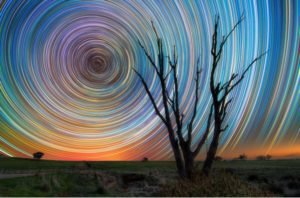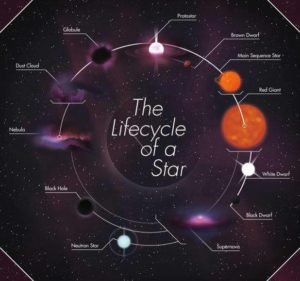“For my part I know nothing with any certainty, but the sight of the stars makes me dream.”~Vincent van Gogh ~
Time lapse photography of stars movement.
The Sun and Stars
Nebulas are stellar nurseries where stars are born. They are beautiful places in our universe of incredible shape and colors! They are huge clouds of spinning balls of gas and dust. Particles are drawn together by gravity and shrink to form pro-stars. As they shrink the particles collide and fuse together and explodes out creating heat and light. It ignites and a star is born. Planetary nebulas are born from the death of old stars.
New stars are blue and white and very bright. Dwarf stars are smaller and last longer. Large giants and super giants have shorter lives. When the supply of gas runs out the star dies. If a cloud spins slowly it creates one star. If a cloud spins fast it creates twin stars.
If a cloud spins medium, a star with planets is born. About ½ stars in universe are double stars.
Our sun is 93 million miles from earth. The sun’s diameter is 869,900 miles. The suns light takes 8 minutes to reach us. There is fusion inside the core of the sun and atoms of hydrogen collapse into each other forming helium and giving off enormous energy. Seventy elements have been identified in the sun by a spectroscope.
The layers of the sun are:
1. core
2. radiation zone
3. convection zone
4. photosphere a sea of boiling gases 10,000 * F – the thin layer of the sun’s surface
5.chromosphere – the inner atmosphere
6. corona the outer atmosphere is the halo you see during a solar eclipse by the moon that stretches far into space and lasts 7 minutes. Sometimes during an eclipse, a diamond ring shines out or “Bailey’s Beads,” little rays that sparkle through an eclipse.
The hottest stars are blue and white. The hottest stars have the brightest light. Medium stars are yellow-orange and cooler stars are red. Small stars fade away. Big stars grow bigger and cooler changing from blue or yellow to red. A red giant may swell to a super giant and explode in a supernova pushing it’s outer layers into space leaving a tiny star, a white dwarf that is very dense and heavy. They are tiny, dense, and give off x-rays. Their weight gives them enormous gravity.
White dwarfs are old stars with a dim light. They may explode to neutron stars or black holes. The neutron star radiates like a lighthouse, is dense, heavy, and spins fast giving off radio waves. One cup of neutron stars weighs a million million tones. 1 cup of white dwarfs is 100 tonnes. There is a gravitational collapse. The red super giant vanishes.
Shooting stars are not stars but meteors that enter our atmosphere and burn up. Stars aren’t moving. The earth is rotating. Stars twinkle because their light wobbles as it passes through our atmosphere. The color of a star reflects the temperature of the star and it’s composition. The star sphere has an equator. There are more than 500,000 million stars are in our galaxy of stars alone.
Galaxies are groups of stars. Galaxies cluster together. There are billions of galaxies. A Spiral galaxy is a flat disc with arms spiraling out from a center bulge. The Milky Way galaxy is a spiral galaxy fairly large at 100,000 light years across. Old stars are in the center. Young stars are in the arms. The whole Milky Way Galaxy of stars spins in space. The milky river of starlight we see in the sky is part of the Milky Way Galaxy. Our solar system is 2/3 of the way out from the center of our galaxy. Galaxies may be barred spiral and arms curl out from a bar. Elliptical galaxies are usually old stars. Some are like squashed balls, and some become irregularwhen they collide with another galaxy. This is the rarest type. The galaxies closest to ours are the large and small Magellanic Clouds that are irregular galaxies. Andromeda is the nearest visible galaxy. Galaxies group together to form super-cluster chains. Our Milky Way Galaxy belongs to a group of galaxies called The Local Group. If you look toward Sagittarius, you are looking toward the center of our galaxy. We are part of the LOCAL GROUP of 32 galaxies. Our sun is the star of the Milky Way Galaxy! If there is no sun then there is no heat, no light, no clouds, no rain, no life. Thereby it shines and spins by the grace of The Creator.
Stars contain 99.8 % of the matter in the solar system. Solar means of the sun. If you weigh 60 lbs on earth, you would weigh 1,680 lbs on the sun. Our sun is a nuclear bomb 5 billion years old and it will continue to burn for 5 billion years more. Heat, light, and electrically charged particles stream out from the sun to the ends of the solar system. Hydrogen is the sun’s fuel. The sun’s gravity locks the planets in orbit. Planets circle the sun. The solar system has 9 planets and 60 moons, millions of asteroids, and billions of comets!
Planets in our solar system are much closer to us than stars. The closer a planet is to the sun, the faster it must move in orbit. The closest star to our solar system is Alpha Centauri. SIRIUS is the brightest star in our sky magnitude 1.4. The faintest stars are mag. 6.
In 1543 Copernicus said planets go around the sun and the earth rotates on its axis. The sun spins on an axis and turns 1 time in 25 days – 27 days at the equator. The sun mystery is that the sun wobbles and shivers getting larger and smaller by10 km. The earth wobbles.
It takes the earth 26,000 years to complete one circle or precession around our galaxy. About 3,000 asteroids located between Mars and Jupiter circle our sun in what we call the asteroid belt. Ceres is the largest asteroid. Billions of space icebergs called comets travel around our sun beyond Pluto forming a huge disc.
When the solar wind lights the sky, the wind is trapped at the poles and causes beautiful auroras. I asked my father one time, “What is the most beautiful thing you have ever seen?,” and he said it was an aurora borealis. The sun constantly blows invisible gases into space. The solar wind is a flow of plasma from the sun that may cause radio blackouts, auroras, and change in the earth’s magnetism. Sunspots occur when giant storms erupt on the surface of the sun. They are cooled areas that are dark spots visible for a few hours or several weeks usually near equator. Solar flares are energy that builds up blasting jets of burning gas into space. Flames or prominences appear that can travel 200 mph and stretch 100 thousand miles. Earth is in the sun’s outer atmosphere. The earth’s atmosphere and magnetic field protect life from the sun.
On a clear night you can see about 2000 stars. There are 88 star pictures called constellations. Many are named for characters in Greek stories. (Orion the hunter is a giant who carried an unbreakable sword. The fuzzy patch of light in the sword is the Orion nebula. Stars go in circles at the poles.
Polaris is 50 times greater than our sun. Hold an umbrella and turn it, Polaris is always at the top. If Polaris sinks, the sailor is going south. If Polaris rises they are going north. If stars rise in the sky / going east. If stars are setting – west. POLARIS stays still. Face north and move arm up ½ way about 45*. There is Polaris, the last star in the handle of the little dipper. The stars aren’t actually moving but the earth is rotating. The ecliptic is the suns path through constellations in the sky called the zodiac.
Activities: Give students a picture of a constellation and let them pick out the glow in the dark stars and stick them on the wall with sticky putty. Let them make star finders. I use small pictures of the polaris constellation. Students punch holes using large push pins through the small stars in the picture through a small square of black construction paper underneath which is placed over a small square of carpet or cardboard. The black paper is placed over the end of a cardboard tube from paper towels and held with rubber band. Look through and you see Polaris! One year we made stars from clay, colored them and put them on a little tree another year we made “sun catchers” using contact paper and colored cellophane. Solar ovens are nice and we also make sun prints. I love to teach them the song “The Stars are Coming Out Like Popcorn”. They love it!

INCREDIBLE 5 YEAR TIME LAPSE OF THE SUN
CLICK HERE TO SEE MORE AMAZING SOLAR PHOTOS
